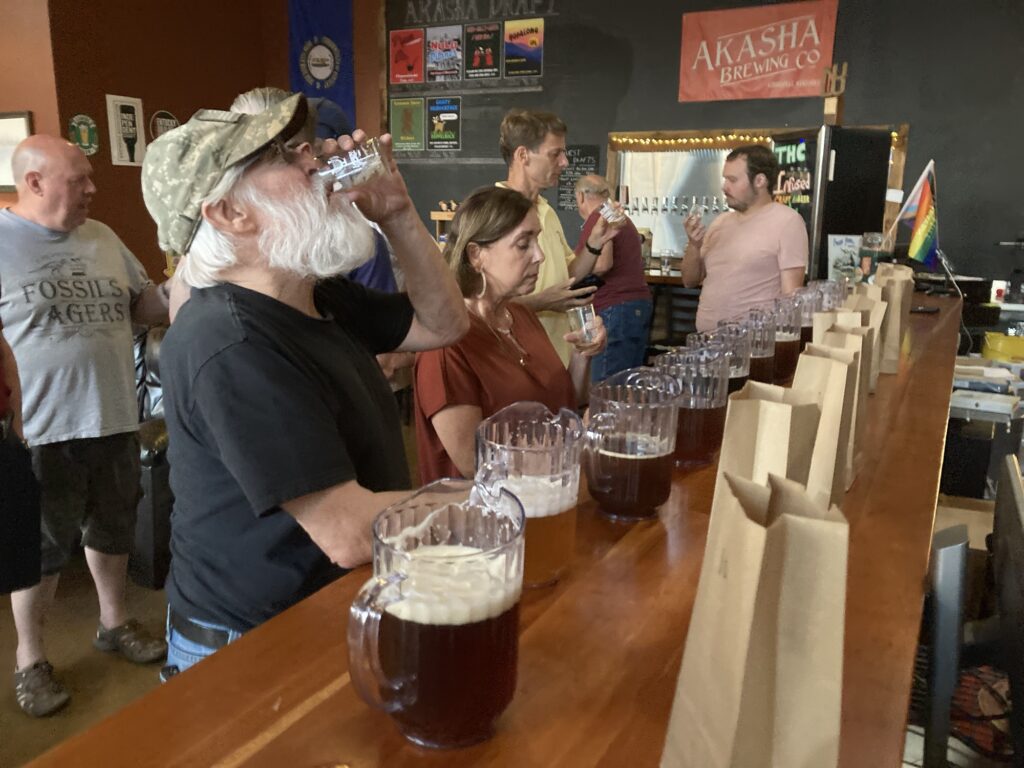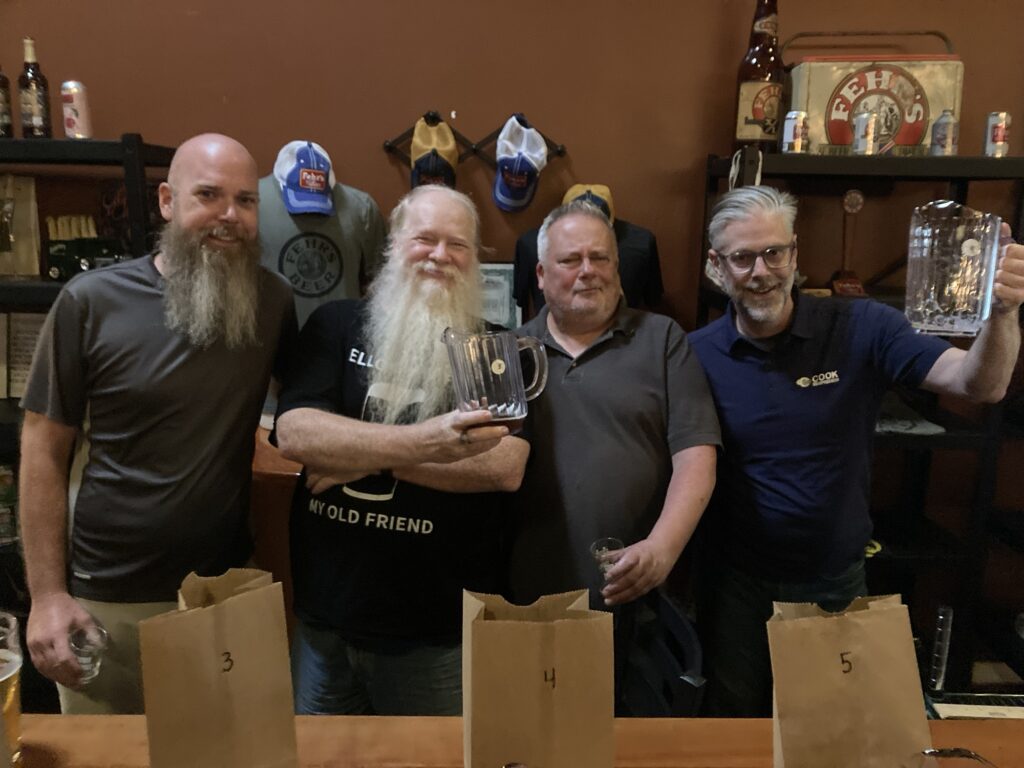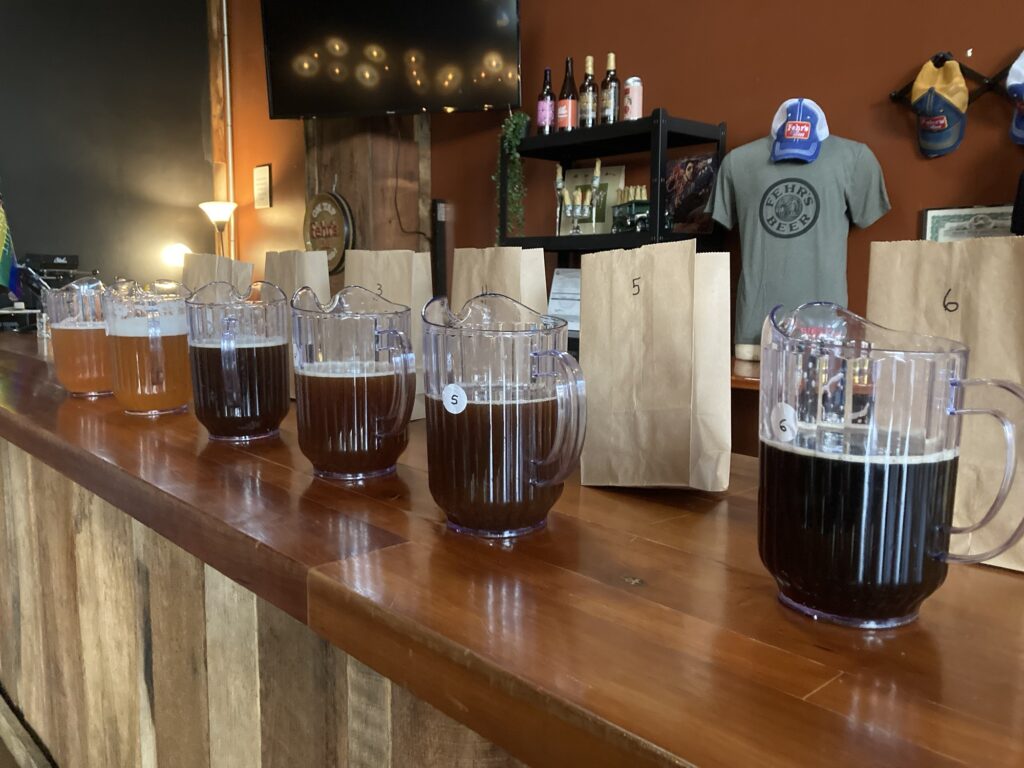Alex R pulls ahead with one round to go
Congrats to Alex R on his second LAGERS Cup round win. If he chooses to submit a stout in December, only Craig M or Tim M will be able to catch him. (Derek T has a chance if Alex doesn’t enter the final round.)

Several other members could place in the overall top 3 with a winning or second-place stout.

Alex’s winning dubbel recipe
Malt
- 52% Weyermann Munich II
- 44% Weyermann Barke Munich
- 4% Caramunich
Hop
- Perle – 13.5 IBU – first wort hop
- Perle – 8.5 IBU – 40 min
Adjunct
- 2lbs homemade invert syrup #3 added to fermenter (or end of boil). Made from sugar in the raw.
Yeast
- WLP500 – ferment at 70°F
Target OG 1.050 prior to the sugar
Alex’s process and lessons learned
“I leaned on my competition experience for this round. I don’t like the phenolic character of most Belgian beers. But, when I brew for competitions, I always try to turn the fewest number of brew days into the most entries. I had planned to brew a dark mild with dark invert syrup and a Munich dunkel.
“Munich dunkel can take on some of the same flavors as Belgian dubbel. But, the ABV is too low, and the body is too high. My hope was that by adding the invert syrup from the mild that it would thin the body and increase the ABV to give me a third batch out of two brew days.
“I brewed 8 gallons of the dunkel, separated 3 gallons into a 2nd fermenter, and added 2lbs of dark invert syrup and pitched WLP500.”
Runners Up: Matt A and Dave H | Craig M
Congrats to Matt A and Dave H, who teamed up for their beer, as well as Craig M. They tied for second and received 7 points this round.

With his previous win and second-place tie, Craig maintained his spot at second overall, while Tim fell from first to third place.
Next Round: December 16 — Stout
Brew any style of stout to compete in the final round of the 2024 LAGERS Cup. Consider submitting next quarter just to see how you do!
How Alex is approaching the final round
“I think I’m going to try to clone Louisville’s favorite coffee stout. I’m going to brew Jamil’s imperial stout recipe from Brewing Classic Styles as the base beer. It’s a nice 8% ABV stout that holds up well to adjuncts.
“I like to use San Diego Super yeast (WLP090) for clean high ABV beers and ferment at the very bottom of the temperature range.”
Alex’s stout tips
- Pitch rate/yeast health – Proper pitch rate is critical for high gravity beers, so a pitch rate calculator can be a big help. Brewers friend has a great one online for free. For example, the proper pitch rate for 5 gallons of 1.080 OG beer is about 400 billion cells. That is 4 packs of dry yeast, or a 2-3 liter starter using the white labs pure pitch packs if the yeast is less than 3 months old. Yeast nutrient will also help a lot in these beers.
- Fermentation temperature – With a proper pitch rate and a high OG, fermentation is going to be vigorous. The temperature inside the fermenter can easily be 10+ degrees warmer than ambient. If you don’t have temperature controlled fermentation, try to do anything possible to keep the temp as low as you can. One easy method is putting frozen two liter bottles around the fermenter with a wet towel wrapped around or draped over. Swap the bottles out every ~24 hours.
- Attenuation – In high gravity beers, the yeast is in a stressful environment so getting it to finish out can be difficult. It may seem counter intuitive for beers where you want to have body, but mash low for maximum attenuation (149F-152F). Most recipes have a lot of caramel and roast malts with a lot of unfermentable sugars that will provide plenty of body. High mash temp combined with a lot of specialty malt can lead to a sickly sweet beer. Cory King from Side Project recommends adding brown sugar to stouts to add some flavor but also help increase attentuation. This could be a good option for extract brewers who can’t adjust their mash temp. I would go with ~1lb brown sugar per 5 gallon batch.
- Dark grains – Dark roasted grains can be tricky to use effectively. It’s easy to get a bitter acrid harshness if over used. Two techniques for limiting the harsh roast flavors are a mash cap or cold steeping. If brewing all grain, consider leaving the dark grains out of the main mash and adding them in right before the sparge. This limits the contact time and reduces the possibility of over extraction. Some brewers will also steep the dark grain in cold water overnight and add directly to the boil the next day, similar to making a cold brew coffee, though I have never tried this method.
2025 Reminder: Scoring System Rewards Participation

Plan to brew in next year’s LAGERS Cup! Many members learned a lot this year trying new styles, and the club enjoyed some of its best meetings voting on LAGERS Cup entries.
More information coming soon on the 2025 beer styles.




